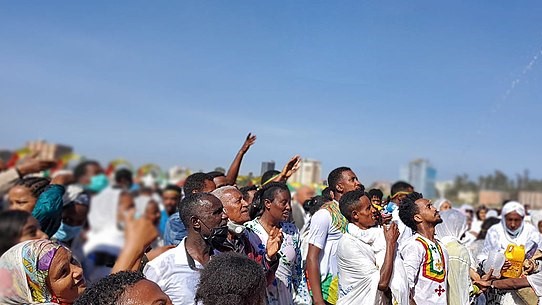In the early hours of January, as dawn breaks across Ethiopia, chants rise in unison and the steady rhythm of drums carries through city streets and rural fields alike. White-robed worshippers gather in vast numbers, their garments accented by vibrant scarves of green, red, and gold. At the heart of this annual spectacle is Timket—the Ethiopian Orthodox celebration of Epiphany, one of the most significant dates in the nation’s religious calendar.
Timket commemorates the baptism of Jesus in the Jordan River, and it remains among the most revered expressions of faith for millions of Ethiopian Christians. The festival begins on the eve of January 19 (or January 20 in leap years), when sacred Tabots—replicas of the Ark of the Covenant—are carried from churches in solemn procession. Accompanied by music, dancing, and the burning of incense, the Tabots are taken to nearby rivers or pools, where an overnight vigil unfolds beneath flickering candlelight and a sky filled with song.
The following morning, priests immerse the Tabots in water, reenacting Christ’s baptism and blessing the waters for the faithful. Crowds surge forward to be sprinkled, a ritual act of renewal believed to cleanse sins and strengthen the spirit. The atmosphere is both jubilant and reverent—part religious ceremony, part communal festival.
Timket is as much a cultural event as it is a spiritual one. Traditional attire fills the streets: women in intricately braided hairstyles adorned with jewelry, men in cloaks embroidered with crosses, children in bright sashes. Color and rhythm dominate the processions, where drums, sistra, and chants form a hypnotic cadence. In cities such as Addis Ababa, modern influences add an urban edge, while in Gondar, the 17th-century castles of Emperor Fasilides provide a dramatic backdrop, evoking the grandeur of Ethiopia’s past.
Food, too, plays a central role in the celebration. Tables are often filled with national staples such as injera, doro wat (spicy chicken stew), and kitfo (seasoned minced beef). Meals are shared communally, embodying the hospitality that underscores Ethiopian culture. The act of breaking bread together serves as a bridge, binding family, neighbors, and visitors alike.
Beyond its immediate rituals, Timket draws thousands of visitors from across the globe. For many, it offers a rare opportunity to witness an ancient Christian tradition that has endured largely unchanged for centuries. Yet for Ethiopians themselves, the festival is less a performance than an affirmation—an expression of identity, continuity, and devotion.
As dusk falls on the final day, the Tabots are returned to their churches in procession, the streets alive once more with chants and song. The spectacle fades, but its echoes remain—an enduring testament to faith, resilience, and the power of ritual in uniting a nation.
Sources:
- Kaplan, Steven. The Beta Israel (Falasha) in Ethiopia: From Earliest Times to the Twentieth Century. New York University Press, 1992.
- UNESCO World Heritage Centre. “Timket Festival in Ethiopia.”
- Marcus, Harold G. A History of Ethiopia. University of California Press, 2002.
- Ethiopian Orthodox Tewahedo Church official communications.


